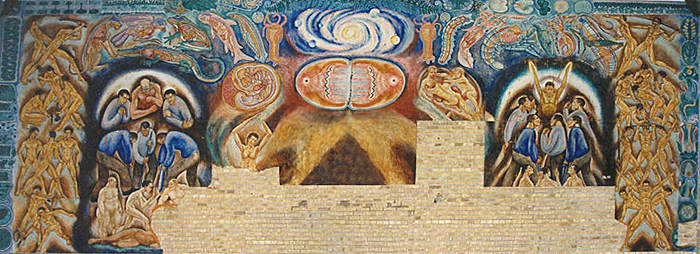After finishing a full year of
art classes at the Art Institute, Haydon's first employment
as a professional artist was an appointment to be a Resident
Artist at Pickering College in Newmarket, Ontario during
the academic year of 1933-34. His introduction to Pickering
College came from his long time association with the Taylor
Statten Camps. Since 1931, Haydon had been teaching arts
and crafts at Camp Ahmek, the boys camp component of the
Taylor Statten Camps, where, incidentally, Harold's brothers,
Ted and Brownlee were also camp counselors, and where they
had all been campers themselves for many of their boyhood
summers. His instruction included all the normal summer
camp craft techniques, like weaving, rug making, leatherwork,
beadwork, as well as painting, drawing, watercolor and
ceramics.

The
mural in the gymnasium of Pickering College has as its theme "the
supreme expression of physical energy through art".
Place your cursor over the image to view the mural in context.
Note: parts of the mural are missing or damaged, but future
restoration may be possible with appropriate funding.
It is important to understand the connection between Haydon and these camps
to know how significant an influence they were to have on his career. Taylor
Statten and his wife Ethel had developed a very successful enterprise of summer
camps, but Taylor Statten was best known in Canada for his progressive educational
practices. The Stattens had Camp Ahmek for boys, Camp Wapomeo for girls, and
a September Camp for adults, all located on Canoe Lake in the Algonquin Park
of northern Ontario. They had previously managed YMCA camps, but in 1912 originated
their own program built on Canoe Lake. To locate the best available counselors
and professionals to staff their ever-growing program, the Statten Camps employed
Dr. Hedley S. Dimock, Dean of George Williams College and Professor of Religious
Education to head their personnel department. Also a member of the personnel
department was Charles E. Hendry, Associate Professor of Sociology at George
Williams College. In addition, Statten, Dimock and Hendry were active members
of the American Camping Association, promoting the value of informal outdoor
education and the socialization benefits of the camping experience. They were
also close personal friends of the entire Haydon family.
In concert with all the normal camp activities, the Stattens maintained a very
active arts program in an open studio format, meaning that the arts studio
was available throughout the day and staffed with an instructor that helped
individuals or groups work in a variety of techniques when and how it most
satisfied their interests. An effective method, the open studio approach was
well suited to the more relaxed summer camp atmosphere. Due to his stature
within the progressive educational community within Canada, Taylor Statten
was asked by Pickering College to recommend someone for their resident artist
program that would complement their own progressive educational environment.
Statten recommended Harold Haydon, as did the Canadian artist Gordon Webber
who was also Statten's director of art activities at the camps and Haydon's
supervisor.
Pickering College is a co-educational independent day and boarding school for
students from Junior Kindergarten through Grade 12. Graduating students then
go on to continue their education at universities and colleges. Pickering was
founded in 1842 by the Quakers first as a coeducational
school, then later as an all boy's school, as it was when Haydon was there,
and now recently it has been converted back to a coeducational institution.
As part of their progressive program, Pickering provided art instruction in
the same open studio format that the Statten camps employed. Pickering also
maintained an artist colony, which provided artists with free room and board
and the freedom to pursue their professional work in exchange for staffing
the open studio. It would be just as Haydon had been accustomed to at summer
camp, but in the more formal setting of a boarding school.
While at Pickering, Haydon was afforded a marvelous opportunity to produce
a mural. It was his first mural as well as his first work as a professional
artist. He found in the gymnasium an expansive, bare, 16' x 44' wall, and with
all the enthusiasm of youth determined to undertake the enormous project of
designing and executing a mural. It was done in oil on fabricated wood, but
unlike the fate of so many other murals that over time or for various reasons
were painted over or lost in a building demolition, Haydon's is fortunate to
still exist. The subject is as ambitious as its scale. It depicts "the
function of a gymnasium and of physical education in this energy-made world
(which) is to sublimate the release of physical energy to the level of art
and to help it serve the needs of a cooperative community." Its borders
incorporate the evolution of both plant and animal life while the main portion
shows on the right the development of physical education and the ideal of a
society "inspired by concepts of brotherhood and cooperation."
On the left is the role of physical activity in North American daily life from
its necessity in early pioneering days to its transformation into leisure time
activities in the modern commercial world. Coupled with this history is depicted
the ever present warning of how force and oppression can over-shadow and degenerate
a healthy society.
In theme, the Pickering mural incorporates Haydon's personal interpretation
of the "healthy mind, healthy body" philosophy from the progressive
educational movement as well as the more generalized social protest themes
common in Depression Era art, especially art influenced by the Mexican Muralist
movement. In style, Josi Clemente Orozco has been cited, as has Rockwell Kent,
as artistic influences on Haydon's mural, but the stylistic flavor of this
work is seen in numerous artists' work from the period. The specific subject: "the
supreme expression of physical energy through art" is undoubtedly unique
to Haydon. He spent several months researching the plant and animal evolutionary
forms and in designing and producing drawings. In early April of 1934 the College
President and Board of Trustees approved his 2' x 5' watercolor drawing. By
late April or early May he had begun. Expecting to be completed in six weeks,
the project took longer than anticipated but was finished later that year in
time for a December 8, 1934 unveiling.
Though enormous, the mural did not occupy all of Haydon's time. He produced
a number of smaller landscape paintings of the area in his straightforward "souvenir" style,
as well as continuing work related to his binocular vision and retinal afterimage
techniques. While making his point emphatic was not something Haydon did often,
when he did, he was always able to blend in just enough humor to soften the
blow. Train Window from 1934 (oil on canvas,
20 x 16" PA0227) is
not in the binocular vision style itself, but is nevertheless an important
statement
for him. We see Haydon looking out a train window; we see his right forearm,
the side of his nose, eyelid and eyelashes. Since it is a moving train, he
correctly shows the scene with blurring caused by the retinal afterimage effect.
So why show his nose and eyelid? Several years later he explained in a letter
to the Art Editor at The Chicago Sun newspaper. This painting was in a 1942
exhibition and his letter to the editor is as follows:
" Last Saturday you wrote that no camera
could take the picture that shows a one-eyed view of landscape, including the
viewer's nose and eyebrow.
You are
right (barring some ghoulish trick) concerning the eyebrow and nose. You are
wrong on the main point concerning the one-eyed view. The ordinary camera does
exactly this - making pictures with a single lens. I painted the picture to show
that painters, including the great masters, might just as well have been blind
in one eye - that the Mona Lisa, for example, could have been painted with one
eye shut. When you paint a picture with both eyes, the result is very different;
everything is double except the things you are looking at which are in the plane
of focus. We all are so used to one-eyed pictures that we don't know what we
really do see with both eyes open. I think painters should use two eyes if they
have them."
|



